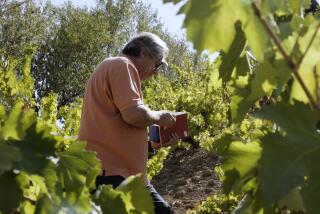Wine and Steel: The Tank Revolution
- Share via
“Barrel-fermented” has become one of the buzzwords snobs love to toss around when chatting about wine, particularly Chardonnay. It is supposedly a mark of distinction, yet it implies that fermentation in something other than a barrel makes a lesser wine.
But the development of stainless-steel fermentation tanks about 40 years ago revolutionized the wine industry. For centuries, wine had been fermented in all sorts of bizarre vessels, yielding all sorts of curious aromas.
Stainless-steel tanks with cooling jackets welded to their sides allow winemakers to control the temperature of the fermentation, which permits better control over the finished product--the winemaker can keep out funky smells that are not an inherent part of the grape.
This advance has made the white wines of Spain, Italy and Portugal fresher and cleaner. Twenty years ago, many of the whites made in those countries “cooked” in their oak vats, or vats lined with slate or concrete when fermentation turned hot.
The chemical process of fermentation produces heat by nature, but if the wine gets too warm it develops what is called volatility; put simply, it smells like nail polish or vinegar. In the old days, you had only primitive ways to avoid this, such as tossing large chunks of ice into the fermenter or pumping the juice over ice and then back into the vat. There were obvious problems with either of these methods--not the least of which was that they watered down the wine.
Besides their technical advantages, stainless-steel fermenters have other--more pedestrian--advantages: They are cheaper (about $1 per gallon, compared with oak barrels at $4 a gallon) and they are easier to clean and work on.
Though better white wine has been stainless steel’s greatest contribution to winemaking, it is also a boon to makers of red wine.
Angelo Gaja, one of the world’s greatest winemakers and one of Italy’s most dynamic personalities, has long believed this. His Barbarescos, made from the Nebbiolo grape native to Piedmont, have been among the most powerful and long-lived red wines in the world, rivaling neighboring Barolo for headlines. Today the cheapest Gaja Barbaresco sells for about double the price of even the best Barolo.
“When we brought the stainless steel into the winery in the late 1960s, we experimented for 10 years before we added more tanks,” Gaja told me last week.
He doesn’t just use them to slow down fermentation. Consider that the origin of the name Nebbiolo: Italian word nebbia, meaning fog. By local tradition, the late-harvested Nebbiolo grape shouldn’t be picked until moistened by morning fog.
“By that time of the year, at the end of October or early November, the temperatures of the winery might be very low,” said Gaja. At such low temperatures, “it was impossible to start the fermentation. We had to wait eight, 10 days before it would begin, and during this time, strange aromas could develop.”
When the fermentation finally did take off, it frequently raced to 90 degrees, shocking the yeasts, which grew weak, slowing the fermentation to a crawl.
“Very often we were not able to finish the fermentation in a reasonable time,” Gaja said, adding that occasionally fermentations dragged on for two or three months, leaving the wine far too astringent and tannic.
By coincidence, a week earlier I had pulled from my cellar a bottle of 1971 Barolo Riserva from the fine producer Franco Fiorina. The wine was wonderfully aromatic and still had good fruit, but the finish--even after more than 20 years of aging--was still tannic.
I told this to Gaja, who nodded and said soberly, “The wines we make today are better.” He explained that with stainless-steel tanks he can now gently warm the juice immediately after the grapes are crushed. This allows the fermentation to start more quickly, avoiding off odors. Once fermentation is under way, the warm liquid in the tanks’ jackets can be changed to a coolant.
Gaja added stainless-steel tanks on a large scale in the late 1970s, but not for all his red wines until 1986. A classic example of this “new” style of Barbaresco may be seen in the 1990 Gaja Barbaresco ($65), an immense wine with complex scents including anise, mint, dried cherries and blackberry jam.
This wine is, in typical Piedmont fashion, quite tannic right now (as Gaja said, “It is not the wine yet”), but with many hours of aeration, the wine actually becomes both more aromatic and less astringent.
More to Read
Eat your way across L.A.
Get our weekly Tasting Notes newsletter for reviews, news and more.
You may occasionally receive promotional content from the Los Angeles Times.






